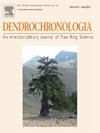Regional NDVI reconstruction based on tree-ring width of Pinus massoniana Lamb. in the north-south transition zone of China
IF 2.3
3区 农林科学
Q1 FORESTRY
引用次数: 0
Abstract
Short-term observational records of the normalized difference vegetation index (NDVI) limit the understanding of climate-driven changes in vegetation productivity and impacts in the context of global warming. The Tongbai Mountains are located in the north-south transitional zone of China and represent the northern boundary of Pinus massoniana Lamb. In this study, we employed the earlywood width (EWW), latewood width (LWW) and total ring width (TRW) chronologies of the existing P. massoniana to investigate the relationships of these chronologies with climate factors and NDVI, and found that tree growth showed significant positive correlations with temperature in March and April and with NDVI in April, May and June. The most significant positive correlations between TRW/EWW/LWW and NDVI in current June (0.79, 0.8, 0.76; p < 0.001) were used for reconstruction since 1929 or 1930. Based on the EWW chronology, one linear regression function accounted for 63.7 % of the variance during 1982–2018 and tracked the observed data well. There were 13 dense and 13 sparse vegetation coverage years (both accounting for 14.13 %), and two dense and two sparse vegetation periods after 11-year smoothing of the reconstructed series. Comparing the reconstructed series with the warm season temperatures, we found that the vegetation coverage in early summer is mainly controlled by the temperature. Spectral analysis revealed that the vegetation cover variations mainly exist 2–3a (p < 0.01) cycle, which may potentially reflect the connection between regional NDVI change and the Quasi-Biennial Oscillation (QBO). Our results are of great significance to long-term prediction and management of dynamic vegetation cover change in the north-south transitional zone of China.
基于马尾松树轮宽度的区域NDVI重建。位于中国的南北过渡带
归一化植被指数(NDVI)的短期观测记录限制了对全球变暖背景下植被生产力的气候驱动变化及其影响的认识。桐柏山脉位于中国南北过渡带,是马尾松(Pinus massoniana Lamb)的北界。利用马尾松早木宽度(EWW)、晚木宽度(LWW)和总年轮宽度(TRW)年表分析了马尾松年表与气候因子和NDVI的关系,结果表明,马尾松生长与3、4月份的温度和4、5、6月份的NDVI呈显著正相关。当前6月TRW/EWW/LWW与NDVI正相关最显著(0.79、0.8、0.76;P <; 0.001)自1929年或1930年以来用于重建。基于EWW年表,1982-2018年期间,一个线性回归函数占方差的63.7 %,很好地跟踪了观测数据。重建序列经过11年的平滑处理后,有13个密集植被覆盖年和13个稀疏植被覆盖年(均占14.13 %),2个密集植被覆盖年和2个稀疏植被覆盖年。将重建序列与暖季温度进行对比,发现初夏植被覆盖度主要受温度控制。光谱分析表明,植被覆盖度变化主要存在2-3a (p <; 0.01)周期,这可能反映了区域NDVI变化与准二年制振荡(QBO)之间的联系。研究结果对中国南北过渡带植被覆盖动态变化的长期预测和管理具有重要意义。
本文章由计算机程序翻译,如有差异,请以英文原文为准。
求助全文
约1分钟内获得全文
求助全文
来源期刊

Dendrochronologia
FORESTRY-GEOGRAPHY, PHYSICAL
CiteScore
5.50
自引率
13.30%
发文量
82
审稿时长
22.8 weeks
期刊介绍:
Dendrochronologia is a peer-reviewed international scholarly journal that presents high-quality research related to growth rings of woody plants, i.e., trees and shrubs, and the application of tree-ring studies.
The areas covered by the journal include, but are not limited to:
Archaeology
Botany
Climatology
Ecology
Forestry
Geology
Hydrology
Original research articles, reviews, communications, technical notes and personal notes are considered for publication.
 求助内容:
求助内容: 应助结果提醒方式:
应助结果提醒方式:


